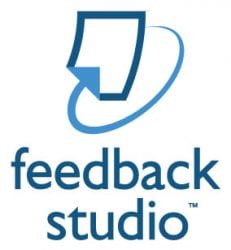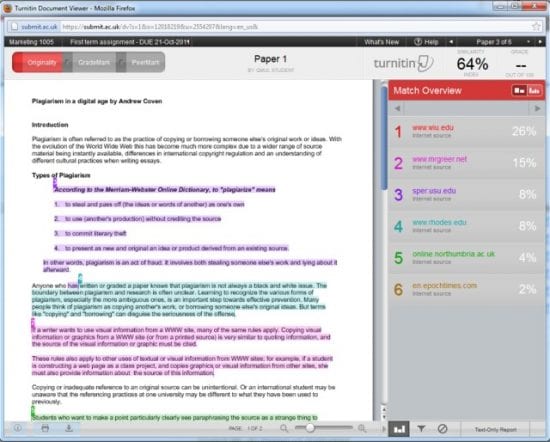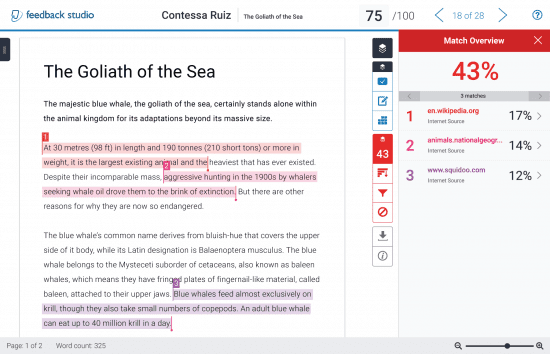Turnitin Revamps, Renames its Core Product
Welcome to my feedback studio...
 Turnitin, with little a doubt, is the best-known name when it comes to originality detection. It’s the product used by more than 26 million students and has seen over 500 million submissions. For many, Turnitin is the only plagiarism detection system they have ever seen or used.
Turnitin, with little a doubt, is the best-known name when it comes to originality detection. It’s the product used by more than 26 million students and has seen over 500 million submissions. For many, Turnitin is the only plagiarism detection system they have ever seen or used.
Simply put, Turnitin is practically synonymous with plagiarism detection for many people.
However, in recent years Turnitin has worked to move away from its plagiarism and originality-checking roots. While still maintaining its content-checking tools, Turnitin has worked to go from being a plagiarism detection system to a full-featured grading platform.
Though it started in 2002 when Turnitin introduced online grading, the process kicked into gear when, in 2010, Turnitin integrated online grading and peer review and other tools into one product. Since then, they’ve been slowly expanding their grading, revision and feedback offerings.
Today though, the company has announced that it’s rebranding and relaunching its core product. Now dubbed Turnitin Feedback Studio, the company is moving to consolidate its offerings and provide the entire slate of services in a simple, mobile-friendly package.
While the relaunch doesn’t add any significant features to the service, it does address two key complaints users have had about the service. More more importantly though, both the name and the new version highlights the direction that Turnitin, and likely originality detection as a whole, is moving.
This makes the release important to note, even if you’re not a current Turnitin user.
Understanding Turnitin Feedback Studio
If you’re a long-time Turnitin user, you likely won’t see any significant changes when setting up a class, an assignment or even accessing individual papers. It’s only when you open an actual paper that the differences become apparent.
Turnitin Feedback Studio has ditched the clunky, frame-driven layout of both its originality detection and grading tools and switched to a modern that uses overlays and extremely simplified interface.
Before

After

This new interface allows it do several things it couldn’t do before.
First, Originality and Grading are no longer on two separate views. Instead, they are layers in the same view that can be enabled and disabled. This not only makes the experience of grading a paper much more cohesive, but closely integrates both the grading and the originality detection components more tightly.
Second, the layout is responsive, meaning that it works equally well on desktop as well as mobile devices. While Turnitin has long offered an app for iPad, mobile compatibility has been one of the most-requested features for Turnitin.
Finally, the feature brings Turnitin closer to compliance with WCAG 2.0 AA standards, which covers the use of the web for individuals with disabilities, in particular blindness. This is of greatest value to visually impaired students, who previously struggled to use Turnitin and receive grades/feedback from it.
All in all, the relaunch and renaming doesn’t bring any major new features. Originality detection, grading and peer review all have nearly the same features, but the new interface greatly modernizes and improves upon what was already there. That makes Turnitin easier, more accessible and presents it as a unified product.
While it might be easy to dismiss the improvements as just a new coat of paint, the announcement and refocus is an important one. Not just for Turnitin, but plagiarism detection as a whole.
Part of the Process
Over the past few years, Turnitin has worked to make plagiarism detection just a part of the grading process, no different than checking a work for grammar, spelling, etc. While the features added over the years have brought it much closer to that goal, the new interface brings the vision to the fruition, showing the entire grading process, including plagiarism detection, as one interface (rather than just one product).
When Turnitin.com launched in 2000, the idea of using automated tools to check student work for plagiarism was a new idea. Now, in 2016, it’s normalized to the point that millions use Turnitin to provide originality verification just as an ordinary part of grading process.
That normalization is crucial to both Turnitin and plagiarism detection as a whole. Plagiarism detection is still a fairly young technology and, like many young technologies, could have been just a fad, doomed to disappear as whims changed.
However, by making it part of the core grading process, Turnitin has established both itself and plagiarism detection in general as an essential part of reviewing student writing. That guarantees that plagiarism detection, and Turnitin, will have a place at universities and schools for a long time to come.
Bottom Line
To repeat, the launch and rebranding doesn’t bring with it any new features. Everything works, more or less, as it did before, just with a new interface. However, the interface does resolve one of the most common complaints about Turnitin, the lack of native mobile support, and the new UI combines what was several separate interfaces into one.
It’s a welcome upgrade and one that will likely be well-loved by instructors (especially those who want to grade on mobile devices) but it speaks volumes about Turnitin’s vision for the future of its product and the industry.
Though Turnitin, to many, may be synonymous with plagiarism detection, that’s not what the company is about. Over the past few years, it’s biggest features and changes have centered around grading and writing feedback, not originality detection. This launch solidifies that and puts all of its offerings on the same footing.
However, this doesn’t mean plagiarism detection is taking a back seat. If anything, this aims to get it into more instructors hands. If plagiarism detection a part of the normal grading process, more instructors will use it and that bodes well for those who fight against plagiarism.
Because the biggest obstacle to stopping plagiarism in the classroom, historically, hasn’t been the technology, but in motivating instructors to use it and giving them the tools and information to use it well.
Hopefully, this new launch will fix that problem, at least for some.
Disclosure: Though the opinions here are my own, I am a paid consultant and blogger for iThenticate and Turnitin.
Want to Reuse or Republish this Content?
If you want to feature this article in your site, classroom or elsewhere, just let us know! We usually grant permission within 24 hours.
